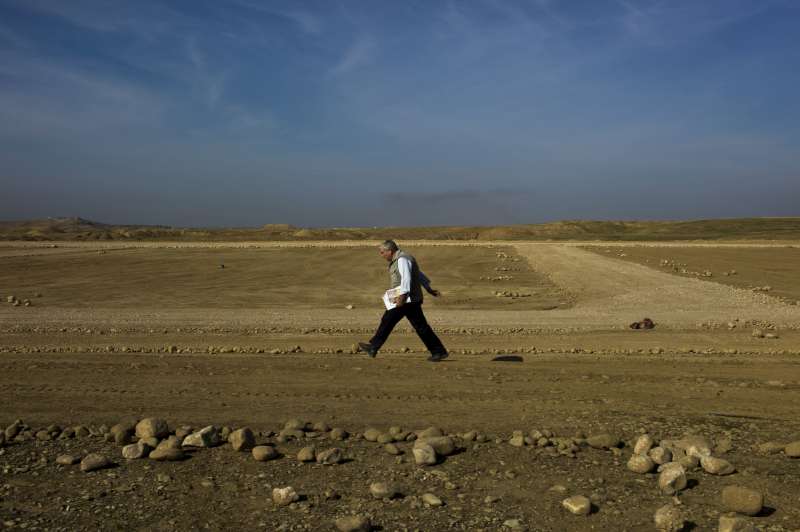
UNHCR’s Chris Nixon walks a camp perimeter, his strides measuring the size of the camp, which UNHCR is building in northern Iraq to house some 2,500 Iraqis displaced by conflict. © UNHCR/D.Nahr
AL WAND 2 CAMP, Iraq, January 15 (UNHCR) – Chris Nixon takes measured, large strides across the swathe of desert that has been flattened and pushed into something resembling a sandy football pitch.
“Sixty meters is the length of a plot,” he calls over his shoulder, during a recent visit by UNHCR colleagues. “We should be able to accommodate at least 500 tent plots on this site.” Each tent will become home to six people, the average size of a family in the region.
The UNHCR technical advisor’s mode of measurement may not be the most accurate, but use of GPS coordinates, tape measures and satellite imagery also comes into play. Nixon has constructed camps and sites for the forcibly displaced across the world.
He typically works in emergency conditions like this one, where UNHCR is taking the lead in planning and constructing a new camp, Al Wand 2, in eastern Iraq’s Diyala province for some 2,500 people displaced by conflict. With the onset of winter, the focus is on speed, accuracy and adherence to internationally acceptable standards for camp construction.
If all goes to plan, New Zealander Nixon and his colleagues will ensure that thousands of uprooted people living in substandard conditions in Iraq will have safe, dry and warm shelter in six to eight weeks.
To date, 25 tented camps have been opened across Iraq to cope with the massive population displacements of the past year in central and northern Iraq, and a further 11 are under construction, some by UNHCR. But Nixon and his crews are also upgrading abandoned buildings for the winter.
Approximately 740,000 internally displaced Iraqis are sheltering in substandard housing, including unfinished apartment blocks, abandoned hotels and smaller structures lacking windows, doors, and in some cases even roofs.
UNHCR is planning on reaching 600,000 of the displaced with some sort of support before the worst of winter; that includes weatherproofing some 5,700 homes and more than 100 larger existing buildings that UNHCR refers to as collective centres.
In the camps, the design process appears to be something like a jigsaw puzzle. There are myriad pieces that must fit together in a coherent fashion, in a limited amount of space. Those puzzle pieces go far beyond tents, and the concrete bases on which they are pitched.
“You must have balance in a site,” Nixon says. “You have the ideal camp at one end of the spectrum, which adheres to global standards. It must provide what the camp residents need: shelter, privacy, access to women’s centers, schools, kitchens, washrooms and latrines.”
He added that ethnic and religious differences often needed to be taken into account. “And we must also ensure we can do all this in the limited space available. In a sense, this is community planning on a small scale.”
That sense of community, where people pull together and the most basic needs are met, does not exist in many of the 2,000 or so locations across Iraq where internally displaced people now temporarily live.
In one such site visited by UNHCR, Khalar village, 67 families are living in housing constructed of plastic sheeting and scrap wood. Given that most say they’ve received little support from the humanitarian community, they seem to cope surprisingly well. An aid agency had delivered family tents that morning.
A refugee was digging a drain, using a plastic pipe laid underground to a home-made covered septic pit. But another refugee said conditions were wretched. “When it rains, it gets so cold; we can’t stay dry. We have to depend on ourselves,” he said.
The people at Khalar will be among the first to move to Al Wand 2 camp when it opens in the near future.
UNHCR’s Nixon, meanwhile, touts the merits of tents over prefabricated shelters. “Tents are fast and effective. With prefabricated shelters, there are issues of cost and procurement. We can provide tented shelter for 10 families for about the same price as one container,” he explains. “These camps are not intended to be a permanent solution, though frequently they are in use for extended periods,” he notes.
By Ned Colt in Al Wand 2 Camp, Iraq


